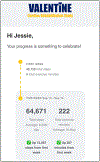Virtual AppLication-supported Environment To INcrease Exercise (VALENTINE) during cardiac rehabilitation study: Rationale and design
- PMID: 35235834
- PMCID: PMC12434840
- DOI: 10.1016/j.ahj.2022.02.012
Virtual AppLication-supported Environment To INcrease Exercise (VALENTINE) during cardiac rehabilitation study: Rationale and design
Abstract
Background: In-person, exercise-based cardiac rehabilitation improves physical activity and reduces morbidity and mortality for patients with cardiovascular disease. However, activity levels may not be optimized and decline over time after patients graduate from cardiac rehabilitation. Scalable interventions through mobile health (mHealth) technologies have the potential to augment activity levels and extend the benefits of cardiac rehabilitation.
Methods: The VALENTINE Study is a prospective, randomized-controlled, remotely-administered trial designed to evaluate an mHealth intervention to supplement cardiac rehabilitation for low- and moderate-risk patients (ClinicalTrials.gov NCT04587882). Participants are randomized to the control or intervention arms of the study. Both groups receive a compatible smartwatch (Fitbit Versa 2 or Apple Watch 4) and usual care. Participants in the intervention arm of the study additionally receive a just-in-time adaptive intervention (JITAI) delivered as contextually tailored notifications promoting low-level physical activity and exercise throughout the day. In addition, they have access to activity tracking and goal setting through the mobile study application and receive weekly activity summaries via email. The primary outcome is change in 6-minute walk distance at 6-months and, secondarily, change in average daily step count. Exploratory analyses will examine the impact of notifications on immediate short-term smartwatch-measured step counts and exercise minutes.
Conclusions: The VALENTINE study leverages innovative techniques in behavioral and cardiovascular disease research and will make a significant contribution to our understanding of how to support patients using mHealth technologies to promote and sustain physical activity.
Copyright © 2022 Elsevier Inc. All rights reserved.
Conflict of interest statement
Dr Nallamothu is a principal investigator or coinvestigator on research grants from the NIH, VA HSR&D, the American Heart Association, and Apple, Inc. He also receives compensation as Editor-in-Chief of Circulation: Cardiovascular Quality & Outcomes, a journal of the American Heart Association. Finally, he is a coinventor on U.S. Utility Patent Number US15/356,012 (US20170148158A1) entitled “Automated Analysis of Vasculature in Coronary Angiograms” that uses software technology with signal processing and machine learning to automate the reading of coronary angiograms, held by the University of Michigan. The patent is licensed to AngioInsight, Inc, in which Dr Nallamothu holds ownership shares and receives consultancy fees. Dr Kheterpal is a principal investigator or coinvestigator on research grants from the US NIH, Blue Cross Blue Shield of Michigan, the American Heart Association, Apple, Merck & Co, and Becton Dickinson & Company; and is a coinventor on US patent number 62/791,257 entitled “Automated System To Medical Procedures,” which is held by the University of Michigan. Dr Klasnja is a principal investigator or a coinvestigator on research grants from NIH.
Figures




References
-
- Tsao CW, Aday AW, Almarzooq ZI, et al. Heart disease and stroke statistics-2022 update: a report from the American Heart Association. Circulation 2022. - PubMed
-
- Thomas RJ, Balady G, Banka G, et al. 2018 ACC/AHA clinical performance and quality measures for cardiac rehabilitation: a report of the American college of cardiology/American heart association task force on performance measures. J Am Coll Cardiol 2018;71:1814–37. - PubMed
-
- Sandesara PB, Lambert CT, Gordon NF, et al. Cardiac rehabilitation and risk reduction: time to “rebrand and reinvigorate. J Am Coll Cardiol 2015;65:389–95. - PubMed
-
- Taylor RS, Brown A, Ebrahim S, et al. Exercise-based rehabilitation for patients with coronary heart disease: systematic review and meta-analysis of randomized controlled trials. Am J Med 2004;116:682–92. - PubMed
Publication types
MeSH terms
Associated data
Grants and funding
LinkOut - more resources
Full Text Sources
Medical

